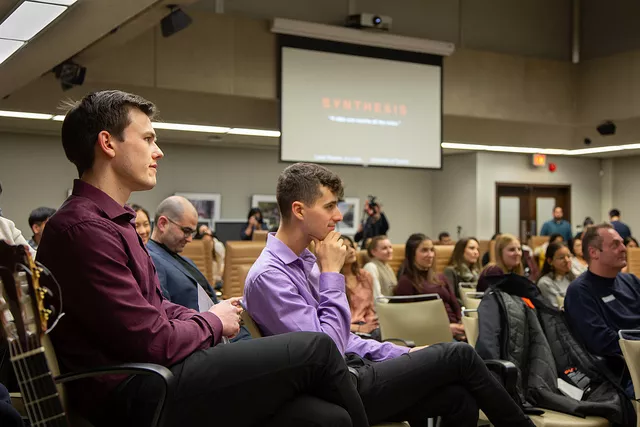
Synthesizing IMI Research at the TedxUofT Salon
On January 29, 2019, the IMI community gathered at UTM for the TedxUofT Salon for an impressive showcase of IMI faculty research that connected with important real-world applications. The Salon’s theme, “Synthesis,” provoked speakers to discuss how ideas are synthesized to become useful products and applications. The three speakers raised important questions: What kind of research grounds commercial applications, and how legitimate is that research? What motivates scientists to apply their research? What practical steps are required to move from basic to applied research?
The first speaker, Prof. Lisa Kramer spoke about the reliance on animal models in scientific research. Bookending the talk with the image of a mouse, Apollo, who had been rescued from biomedical research, she questioned the efficacy of animal modelling in clinical research trials. The harm of animal models lies not only in the suffering inflicted on animals, but also includes the economic and medical harms to patients, to scientists, taxpayers, and corporate stakeholders from wasted resources and opportunity costs due to failure to identify promising new drugs. Prof. Kramer noted that the money raised from big public campaigns—such as the splashy “ice bucket challenge”—often went towards funding animal research, in part because of legal and ethical requirements. Highlighting the scientific, ethical, and economic flaws in animal models, Prof. Kramer urged funding agencies and scientists to more critically examine animal models and explore other methods for research, such as personalized genomic medicine.
The second speaker, Prof. Nico Lacetera, drew on his expertise in the social psychology of motivation to ask: what motivates scientists to translate research into commercial applications? He argued that motivation is a profoundly social and meaning-driven phenomenon. In contrast to models in economics, people are not just driven by economic incentives, but rather are motivated by drive for meaning, mission, fairness, and equity. In general, people work harder if they see the work as aligning with their political values: as one experiment showed, participants worked faster when tasked with stuffing envelopes with messages from the political candidate that aligns with their views. As Prof. Lacetera demonstrated, we must tap into the social and ethical dimensions of work in order to understand how and why research becomes translated into commercial incentives. Corporations, for instance, often profess mission statements and corporate social responsibility in order to tap into this drive to seek meaning and express personal values through work. Holding a belief in the intrinsic value of that research, the potential benefits to humanity, or the drive to foster fairness and equity are all part of this process of synthesis.
Lastly, Prof. Leigh Revers spoke about his first-hand experience in the biotech industry. From a PhD in basic biochemistry research, he transitioned to become the CEO of a biotechnology company, Molecular Templates, Inc. He walked the audience through the nitty-gritty backroom negotiations required to secure funding and partnerships for his company during a difficult economic climate. Exhorting the audience to stay persistent in the face of obstacles, Prof. Revers recounted how in 2008, the same week they gave the final presentation to potential investors, the market crashed. At the interface of scientific knowledge and practical applications, biotechnology firms apply research in the life sciences to create new goods and services that can benefit society, resulting in innovative new drugs and treatments.
As these three talks reveal, the path from scientific research to commercial applications is far from straightforward and can be influenced by everything from scientists’ motivations to the state of the macro-economy. Each speaker delved into the rich nexus of science, technology, and business that is the hallmark of IMI research.
Check out photos from the event here!
